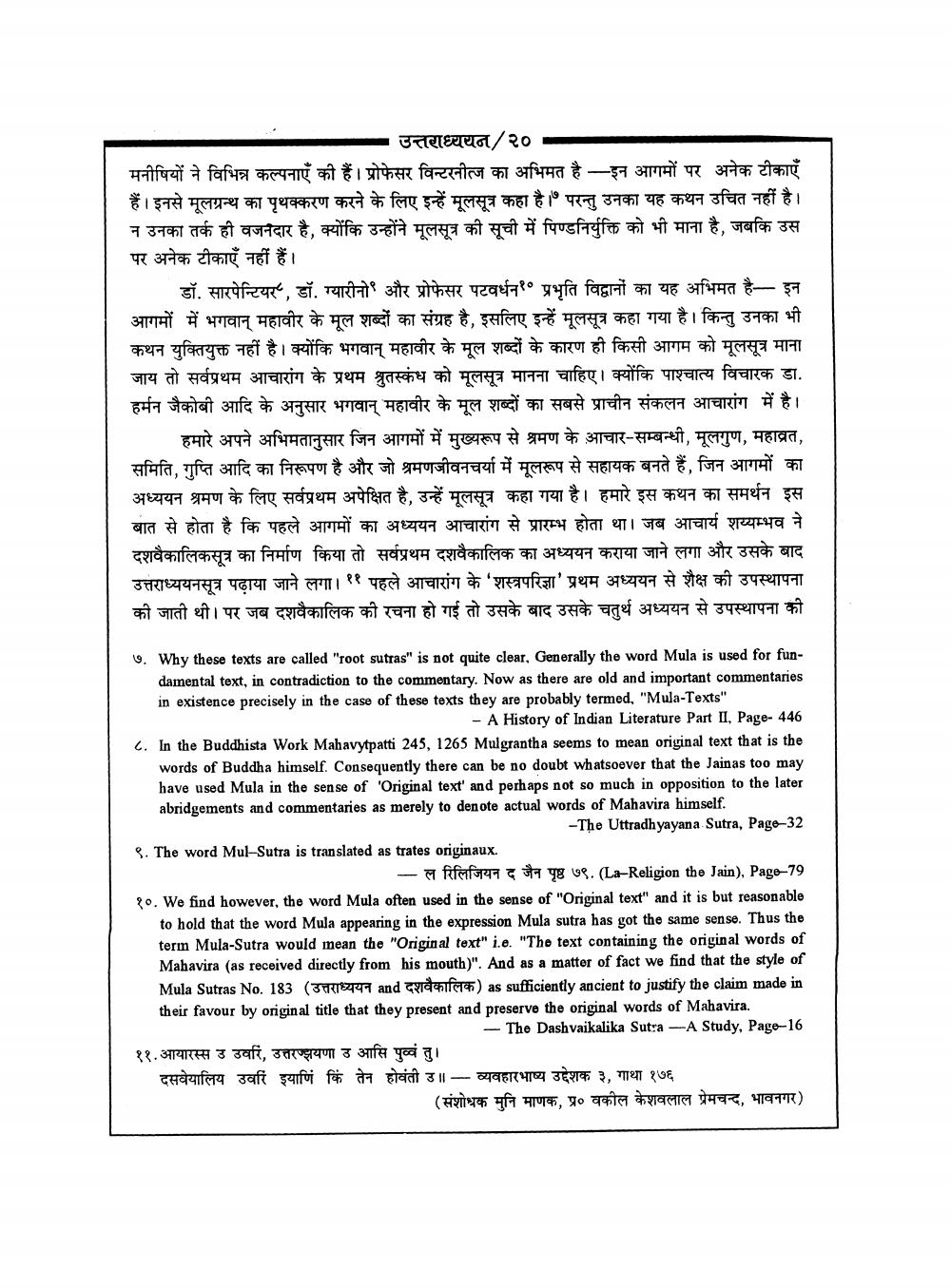________________
उत्तराध्ययन/ २० मनीषियों ने विभिन्न कल्पनाएं की हैं प्रोफेसर विन्टरनीत्ज का अभिमत है इन आगमों पर अनेक टीकाएँ हैं। इनसे मूलग्रन्थ का पृथक्करण करने के लिए इन्हें मूलसूत्र कहा है । परन्तु उनका यह कथन उचित नहीं है। न उनका तर्क ही वजनदार है, क्योंकि उन्होंने मूलसूत्र की सूची में पिण्डनिर्युक्ति को भी माना है, जबकि उस पर अनेक टीकाएँ नहीं हैं।
डॉ. सारपेन्टियर, डॉ. ग्यारीनो' और प्रोफेसर पटवर्धन" प्रभृति विद्वानों का यह अभिमत है— इन आगमों में भगवान् महावीर के मूल शब्दों का संग्रह है, इसलिए इन्हें मूलसूत्र कहा गया है। किन्तु उनका भी कथन युक्तियुक्त नहीं है। क्योंकि भगवान् महावीर के मूल शब्दों के कारण ही किसी आगम को मूलसूत्र माना जाय तो सर्वप्रथम आचारांग के प्रथम श्रुतस्कंध को मूलसूत्र मानना चाहिए। क्योंकि पाश्चात्य विचारक डा. हर्मन जैकोबी आदि के अनुसार भगवान् महावीर के मूल शब्दों का सबसे प्राचीन संकलन आचारांग में है।
1
हमारे अपने अभिमतानुसार जिन आगमों में मुख्यरूप से श्रमण के आचार-सम्बन्धी मूलगुण, महाव्रत, समिति, गुप्ति आदि का निरूपण है और जो श्रमणजीवनचर्या में मूलरूप से सहायक बनते हैं, जिन आगमों का अध्ययन श्रमण के लिए सर्वप्रथम अपेक्षित है, उन्हें मूलसूत्र कहा गया है। हमारे इस कथन का समर्थन इस बात से होता है कि पहले आगमों का अध्ययन आचारांग से प्रारम्भ होता था। जब आचार्य शय्यम्भव ने दशवैकालिकसूत्र का निर्माण किया तो सर्वप्रथम दशवेकालिक का अध्ययन कराया जाने लगा और उसके बाद उत्तराध्ययनसूत्र पढ़ाया जाने लगा। ११ पहले आचारांग के 'शस्त्रपरिज्ञा' प्रथम अध्ययन से शैक्ष की उपस्थापना की जाती थी। पर जब दशवैकालिक की रचना हो गई तो उसके बाद उसके चतुर्थ अध्ययन से उपस्थापना की
७. Why these texts are called "root sutras" is not quite clear, Generally the word Mula is used for fun - damental text, in contradiction to the commentary. Now as there are old and important commentaries in existence precisely in the case of these texts they are probably termed, "Mula-Texts"
- A History of Indian Literature Part II, Page - 446 ८. In the Buddhista Work Mahavytpatti 245, 1265 Mulgrantha seems to mean original text that is the words of Buddha himself. Consequently there can be no doubt whatsoever that the Jainas too may have used Mula in the sense of 'Original text' and perhaps not so much in opposition to the later abridgements and commentaries as merely to denote actual words of Mahavira himself.
-The Uttradhyayana Sutra, Page-32
९. The word Mul - Sutra is translated as trates originaux. - ल रिलिजियन द जैन पृष्ठ ७९. (La - Religion the Jain), Page 79 १०. We find however, the word Mula often used in the sense of "Original text" and it is but reasonable to hold that the word Mula appearing in the expression Mula sutra has got the same sense. Thus the term Mula-Sutra would mean the "Original text" i.e. "The text containing the original words of Mahavira (as received directly from his mouth)". And as a matter of fact we find that the style of Mula Sutras No. 183 ( उत्तराध्ययन and दशवैकालिक) as sufficiently ancient to justify the claim made in their favour by original title that they present and preserve the original words of Mahavira. - The Dashvaikalika Sutra - A Study Page - 16
-
११. आयारस्स उ उवरिं, उत्तरण्झयणा उ आसि पुव्वं तु । दसवेयालिय उवरिं इयाणिं किं तेन होवंती उ ॥
व्यवहारभाष्य उद्देशक ३, गाथा १७६
(संशोधक मुनि माणक, प्र० वकील केशवलाल प्रेमचन्द, भावनगर)
-




